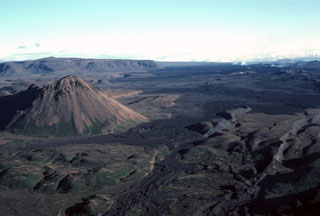Report on Krafla (Iceland) — February 1978
Scientific Event Alert Network Bulletin, vol. 3, no. 2 (February 1978)
Managing Editor: David Squires.
Krafla (Iceland) Inflation continues, after intrusion of 80 x 106 m3 in January
Please cite this report as:
Global Volcanism Program, 1978. Report on Krafla (Iceland) (Squires, D., ed.). Scientific Event Alert Network Bulletin, 3:2. Smithsonian Institution. https://doi.org/10.5479/si.GVP.SEAN197802-373080
Krafla
Iceland
65.715°N, 16.728°W; summit elev. 800 m
All times are local (unless otherwise noted)
"Since 22 January, the center of Krafla caldera has been inflating at a similar rate as before. It is expected that the level at which previous deflation events were triggered could be reached near the end of June. The center of the January rifting is about 40 km N of the center of Krafla caldera. Large-scale rifting took place as in previous events, but weather conditions have prevented detailed measurements. The volume of magma estimated to have left the central reservoirs below Krafla caldera during this event is 80 x 106 m3. This remained below the surface, since no eruption took place. The site of the main rifting is just S of the area where the main rifting took place following the initial outbreak in December 1975, but is about 10 km N of other events since 1975. This is a marked change in behavior, as all other rifting events along the fault swarm have been centered closer to the caldera. According to newspaper reports, the geothermal power station recently built within Krafla caldera has now started electricity production at 7-8 megawatts."
Geological Summary. The Krafla volcanic system in the Northern Volcanic Zone (NVZ) of Iceland is about 100 km long, consisting of a fissure swarm and a central volcano with a 7 x 9 km caldera formed about 110,000 years ago that deposited a rhyolitic welded tuff. It has been moderately active in the Holocene, over three distinct eruptive periods; the current one has lasted about 2,800 years with six volcano-tectonic episodes, each with one or more basaltic fissure eruptions. Lava volumes (DRE) have been in the 0.1-1 km3 range. The Hverfjall and Ludent tuff rings east of Myvatn were erupted along the fissure system. Myvatn lake formed during the eruption of the older Laxarhraun lava flow from the Ketildyngja shield volcano of the Fremrinamur volcanic system about 3,800 years before present (BP); The present Myvatn lake is constrained by the roughly 2,000 years BP younger Laxarhraun lava flow from the Krafla volcanic system. The abundant pseudocraters that form a prominent part of the Myvatn landscape were created when the younger Laxarhraun lava flow entered the lake. The last eruption took place in 1975-1984 CE when nine small basaltic fissure eruptions produced 0.25 km3 of lava.
Information Contacts: K. Grönvold, NVI.

